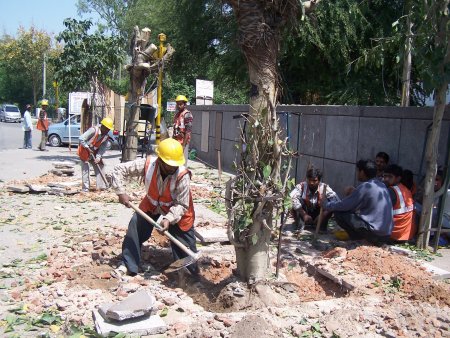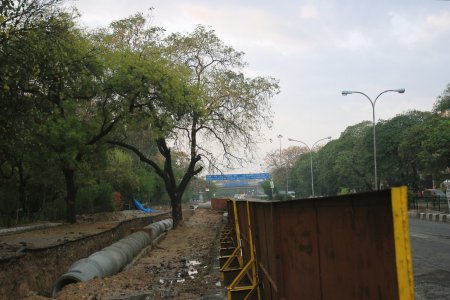 FEATURE FEATURE
|
Don’t axe the tree, integrate it with transport
Ravi Agarwal
Source: Toxics Link, Date: , 2007
Roadside and neighborhood trees in cities like Delhi have been part of the
contemporary urban landscape for over a century. They have more than an
aesthetic value. On any summer’s day, the red light or the bus stop
automatically ‘shifts’ below the nearest tree for scooterists or for
pedestrians. Waiting below them is an obvious choice as temperatures can be
several degrees lower here. Besides, on pavements, hawkers and water sellers
cluster below their shade for some relief from the scorching heat. Semul, dhak,
jasmine or jacaurnada bloom at different times (along with bird nesting), jamuns
or imli for fruit, or neem etc. for leafy shelter. Several species of birds -
sparrows, pigeons, kites, sunbirds, barbets, even hornbills - all nest in them,
and form micro ecologies. All provide a welcome barrier between people’s homes
and the road. Yet today they are dispensable in the eyes of the transport
planner.
 Over the past few years, from available figures, over 50,000 trees have
already been axed in Delhi, some over 50 to 100 years old, and probably an
additional similar number will go before the Commonwealth Games. The pride of
Delhi, the Metro, the upcoming mass transport – High Capacity Bus Service
(HCBS – 6 stretches totaling over 100 km) with dedicated corridors, new
flyovers, road widening, new roads, none consider trees to be important. The
transport planner considers the width between two rows of houses as ‘right of
way’ and anything in-between is fair game. Hence for the purposes of
‘transport’ trees are obstructions. It is not realized that trees are an
essential part of people’s neighborhoods. Over the past few years, from available figures, over 50,000 trees have
already been axed in Delhi, some over 50 to 100 years old, and probably an
additional similar number will go before the Commonwealth Games. The pride of
Delhi, the Metro, the upcoming mass transport – High Capacity Bus Service
(HCBS – 6 stretches totaling over 100 km) with dedicated corridors, new
flyovers, road widening, new roads, none consider trees to be important. The
transport planner considers the width between two rows of houses as ‘right of
way’ and anything in-between is fair game. Hence for the purposes of
‘transport’ trees are obstructions. It is not realized that trees are an
essential part of people’s neighborhoods.
It goes without saying, that transport is important, but it too needs to be
sanely planned. The approach must be for integrating concerns, and not to
force ‘corridors’ the city, where trees are the first casualties. The proposed
road tunnel through the Sunder Nursery is a case in point. Delhi is adding
over 900 cars every day to its existing over 30 million on its roads. Each car
takes the space of two trees.
On the other hand less than 7,000 buses play in lieu of the needed 9,000.
Obviously mass transport need to be increased and cars limited. However road
plans are not accounting for this. For example after10 pm any evening, there
is comparatively no traffic on Delhi’s roads, and one can drive at over 60 km
per hour on many stretches. Yet transport corridors seem to be carved out for
a few hours of car traffic intensity. As an engineer will confirm, ‘channel’
capacity must not be optimized for peak loads, and that any city in the world
will have traffic slow downs in peak hours.
Projects like the HCBS based on dedicated corridors, need to be fully
supported for their ability to transport over 10,000 office goers per hour in
buses, both for their transport efficiency as well as carbon saving, but they
also need to limit road space for cars, not merely expand the corridor.
Roadside trees are equally important to pedestrians and cyclists since no one
will use a concrete walkway in the mid-summer heat if it has no shade. Yet
transport planners do not currently consider the idea of a dedicated tree
line, even if it may seem logical.
These projects will take out many existing trees, and not leave or make space
for new plantations. Without any un-tarred land being allotted on the ground,
trees cannot be planted. In reality the city is facing simultaneous road
widening, new flyovers, new metros, new bus lanes all in one go for the
Commonwealth Games. There is a dire need for planning to account for existing
topographies rather then impose a new barrenness onto it and integration is
the answer.
Any city needs traffic management, as London has shown by taxing car entry,
and cannot be open-ended. While mass transport must be brought in,
simultaneously car traffic needs to be discouraged. Agencies like the ECPA
(Bhure Lal Committee) have been arguing for this, but it seems the ‘car’ lobby
is much stronger.
 The Delhi Tree Preservation Act mandates, among other things, that for each
tree cut compensatory afforestation in a ratio of 1:10 must be carried out.
This though does not compensate for the ‘neighborhood tree. Even otherwise,
often land is not available for it, or provided at a great distance, wrong
species are planted, or survival rates are less than 50%. Inspections carried
out by citizen’s groups show crowded plantation which will have to be
drastically thinned once the trees become a little mature, defeating the
purpose of even the 1:10 ratio. In any case, a new sapling cannot compensate
for a 50-year-old tree, or for a neighborhood tree. The Delhi Tree Preservation Act mandates, among other things, that for each
tree cut compensatory afforestation in a ratio of 1:10 must be carried out.
This though does not compensate for the ‘neighborhood tree. Even otherwise,
often land is not available for it, or provided at a great distance, wrong
species are planted, or survival rates are less than 50%. Inspections carried
out by citizen’s groups show crowded plantation which will have to be
drastically thinned once the trees become a little mature, defeating the
purpose of even the 1:10 ratio. In any case, a new sapling cannot compensate
for a 50-year-old tree, or for a neighborhood tree.
Each year the Government works with citizens to plant new trees. In Delhi a
Greening Action Plan is prepared annually with targets and goals. Saplings are
provided free from nurseries, and students partake in tree planting drives
along with NGOs. However when these trees are suddenly and silently axed, they
become ‘government property!’ While neighborhoods are transformed, no one is
asked, told or consulted even though such transport could take years to plan.
A consultative process can in fact reap good results. In cities like Pune, for
example, monthly public consultations have managed to save many trees from the
unnecessarily axe.
In the larger scheme of things those with powers to protect the trees such as
the statutory ‘Tree Officer,’ need more teeth and budgets. In Delhi the
Planning Commission has sanctioned over 9000 crores for the Commonwealth
Games, half of which is for transport but it is unlikely there any money in it
for ‘trees’ As a crisis response, Trees for Delhi, a new coalition of well
known NGOs and citizens, says that trees are ‘not dispensable’ in their
signature campaign supported by well know people.
Trees must be made a mandatory part of the roadside. Anyone who has watered or
seen a tree grow will know that it takes years of sun, water, and caring for
it to become what it can be. On the other hand, it takes less than minute to
run a power saw through it for it to be felled. Many things can be done to
improve the situation. For example old and heritage trees can be protected at
the planning stage itself, and trees protected or a place made to plant them
again on the edge of the road. New trees can be locally planted alongside new
roads, new flyovers, or when new road widening is carried out with a dedicated
tree line. Resident Welfare Associations can educate local councilors about
the need to protect trees and ensure that they take this up with the Transport
and Environment Departments.
In case trees have to be cut, all information of ‘which,’ ‘when’ and ‘where’
should be shared with the residents of locality and put in the public domain.
Importantly, laws to restrict the number of cars on the roads, or at least
stagger their use of road space is critical. Above all, tree lanes are as
important as pedestrian, cycle, car and bus lanes. These need to be made
integral to transport planning.
|
|

